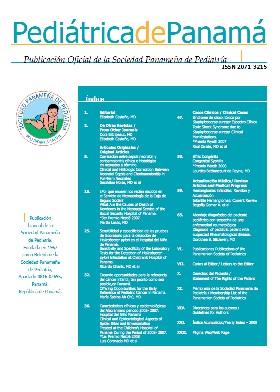Diagnostic challenge
Authors
DOI:
https://doi.org/10.37980/im.journal.rspp.20221954Keywords:
Pediatrics, osteomyelitis, Sickle cell diseaseAbstract
Current process
A 7-month-old male infant was evaluated for limited mobility and increased volume of the right knee and thigh of 24 hours of evolution. No other associated symptoms. No pathological history of interest. History of blunt trauma to the right knee 5 days prior to admission and respiratory viral symptoms 9 days ago.
Physical examination
Limitation of mobility and increase in volume of the right leg, warm and not erythematous. Pain on palpation in the knee and lower 1/3 of the thigh. Palpable and symmetrical peripheral pulses. Rest of extremities without pathological findings.
Complementary tests
Blood analysis: Hb 7.8 g/dL, HtO 23%, leukocytes 23.8 x 103 u/L (N 58.4%, L 25.9%), platelets 183 x 103 u/L. ESR 54 mm/h, CRP >9 mg/dL. Normal lower limb radiography. Ultrasound of the right lower limb ruled out articular effusion visualizing faint inflammatory changes of the periarticular subcutaneous fat.
Evolution
In view of these findings, it was decided to admit the patient to hospital for antibiotic treatment with oxacillin and clindamycin. At 24 hours, growth of gram-negative bacillus in peripheral blood culture, antibiotic therapy was changed, omitting oxacillin and adding ceftriaxone to the treatment. Salmonella enteritidis was isolated in peripheral blood culture.
Hemoglobin electrophoresis was requested: HbA1 86.5%, HbA1c 4.7%, HbA2 3.4%, HbF2.8% and lymphocyte subpopulations were normal, ruling out sickle cell anemia.
What would be the diagnostic suspicion?
Septic arthritis. Bone tumor.
4. Bone infarction.
ANSWER: Osteomyelitis.
Osteoarticular infections are an important cause of morbidity and mortality worldwide. Among the osteoarticular infections, osteomyelitis is the most frequent. It is defined as bone inflammation of infectious origin, generally unifocal, affecting the metaphysis of long bones (femur in 30% of patients, tibia in 22% and humerus in 12%). It predominates in males in a 2:1 ratio, and is more frequent in children under 5 years of age [1].
Although it occurs in up to 50% of cases in healthy patients, there are certain pathologies that predispose to its appearance: among these, prematurity, wounds and trauma, immunodeficiencies, contact with animals or people with tuberculosis and sickle cell anemia stand out.
The etiology is generally bacterial, due to hematogenous dissemination, with S. aureus being the main germ in all age groups. However, there are other causative microorganisms in patients with associated risk factors, such as Neisseria meningitidis in patients with complement deficiency and Salmonella enteritidis in children with sickle cell disease or immunodeficiencies. In addition, we must take into account the significant increase of Kingella kingae as a pathogen causing osteomyelitis, currently being the second most frequent bacterium in infants [2].
It should be noted at this point that although Salmonella osteomyelitis is widely described in patients with sickle cell disease, its presence in healthy patients is unusual. It has been described that asymptomatic carrier status after gastrointestinal infection could pose a risk of infections, however, the presence of sickle cell disease should be ruled out by hemoglobin electrophoresis [3].
Clinical manifestations are nonspecific, and general symptoms such as irritability may be present, especially in neonates and infants. Fever is not always present, being more frequent in septic arthritis. Local symptoms include pain at the fingertips, decreased mobility of the affected area, refusal to ambulation or lameness. Due to the nonspecificity of the symptoms, its diagnosis in early stages is difficult to make, however, given the risk of permanent sequelae, clinical suspicion is important [1].
Among the complementary tests, we include as first-line tests, blood analysis, blood culture and culture of the lesions, radiography and ultrasound. Blood tests should always be requested, including a complete blood count and acute phase reactants. The most frequent findings are leukocytosis, increased ESR in up to 80-90% of patients and increased CRP. A blood culture and culture of the lesion should be taken since blood culture has a yield of less than 50%. In relation to imaging tests, plain radiography is usually normal in the first 14 days; nevertheless, it is essential to perform it to rule out other pathologies. Osteopenia and periosteal changes are usually visible after 10 days. Ultrasound may show subperiosteal abscesses in complicated osteomyelitis and joint effusion, although this is not pathognomonic of infection. The gold standard for the diagnosis of osteomyelitis is magnetic resonance imaging due to its high sensitivity and specificity, since it allows the extension and anatomical location of the abscesses to be seen. However, given its lower availability and the need for sedation in young children, its use is restricted to those patients who present a torpid evolution. Another more frequently used test is bone scintigraphy with Tc 99, which is the most sensitive test for the detection of osteomyelitis in the first 48-72 hours and is especially useful for ruling out multifocality [4].
Regarding treatment, in case of any suspicion of osteomyelitis, the patient should be admitted and empirical and intravenous antibiotic treatment should be started. The choice of antibiotic will depend on the patient's age, risk factors and resistance pattern in the environment. In the case of children under 3 months of age, the antibiotic of choice will be cloxacillin or oxacillin associated with cefotaxime or gentamicin. Between 3 months and 5 years of age, cefuroxime or cloxacillin associated with 3rd generation cephalosporins can be used, and in patients older than 5 years cloxacillin or cefazolin. As for the duration of treatment, it should not be less than 10-14 days intravenous and complete at least 20 days orally in cases of uncomplicated osteomyelitis, however, it should be individualized according to the microorganism that is isolated and according to clinical and analytical parameters, and it may be necessary to complete 6 weeks. In the clinical case in question, the duration of treatment should be no less than 4-6 weeks [5].
Finally, the indication for surgery will be relegated to patients requiring biopsy, septic arthritis, which may be associated in up to 30% of cases, neurological complications, patients requiring drainage of subperiosteal or intraosseous abscesses or lack of response to antibiotic treatment in 48-72 hours, as occurred in our case [1].
Referencias/References
[1] Rubio San Simón A, Rojo Conejo P. Osteomielitis y artritis séptica. Pediatr Integral 2018; XXII (7): 316 – 322.
[2] Gómez Ochoa SA, Sosa Vesga CD. Una visión actualizada sobre factores de riesgo y complicaciones de la osteomielitis pediátrica. Rev Cubana Pediatr. 2016;88(4):463-482.
[3] Penín Antón M, Gómez Carrasco JA, Leal Beckouche M, García de Frías E. Osteomielitis por Salmonella grupo B en paciente portador sano. An Pediatr (Barc) 2005;62(2):178-84.
[4] Woods C, Bradley J, Chatterjee A et al. Clinical Practice Guideline by the Pediatric Infectious Diseases Society and the Infectious Diseases Society of America: 2021 Guideline on Diagnosis and Management of Acute Hematogenous Osteomyelitis in Pediatrics, J Pediatric Infect Dis Soc. 2021 Sep 23;10(8):801-844. doi: 10.1093/jpids/piab027. PMID: 34350458.
[5] Saavedra-Lozano J, Calvo C, Huguet Carol R et al. Documento de consenso SEIP-SERPE-SEOP sobre el tratamiento de la osteomielitis aguda y artritis séptica no complicada. An Pediatr (Barc). 2015;82 (4):273.e1-273.e10. doi: 10.1016/j.anpedi.2014.10.005
Downloads
Published
Issue
Section
License
Copyright (c) 2022 Infomedic Intl.Derechos autoriales y de reproducibilidad. La Revista Pediátrica de Panamá es un ente académico, sin fines de lucro, que forma parte de la Sociedad Panameña de Pediatría. Sus publicaciones son de tipo gratuito, para uso individual y académico. El autor, al publicar en la Revista otorga sus derechos permanente para que su contenido sea editado por la Sociedad y distribuido Infomedic International bajo la Licencia de uso de distribución. Las polítcas de distribución dependerán del tipo de envío seleccionado por el autor.






